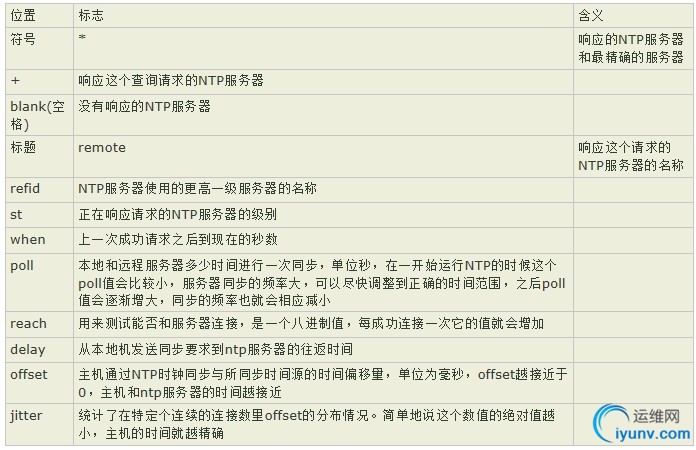|
目标环境,3台CentOS 6.6,一台作为NTPD服务与外部公共NTP服务同步时间,同时作为内网的NTPD服务器,其他机器与这台服务做时间同步。

1、NTP时间同步方式选择
NTP同步方式在linux下一般两种:使用ntpdate命令直接同步和使用NTPD服务平滑同步。有什么区别呢,简单说下,免得时间长了,概念又模糊。
现有一台设备,系统时间是13:00 , 真实的当前时间(在空中,也许卫星上,这里假设是在准备同步的上级目标NTP服务器)是:12:30 。如果我们使用ntpdate同步(ntpdate-u 目标NTP服务器IP),操作系统的时间立即更新为12:30,假如,我们的系统有一个定时应用,是在每天12:40运行,那么实际今天这个的任务已经运行过了(当前时间是13:00嘛),现在被ntpdate修改为12:30,那么意味作10分钟后,又会执行一次任务,这就糟糕了,这个任务只能执行一次的嘛!!我想你(其实是我)已经懂了ntpdate时间同步的隐患,当然这个例子有些极端,但的确是有风险的,生产环境我不打算这么干,还是稳妥点好。所以解决该问题的办法就是时间平滑更改,不会让一个时间点在一天内经历两次,这就是NTPD服务方式平滑同步时间,它每次同步时间的偏移量不会太陡,是慢慢来的(问:怎么来,没有细究,只晓得一次一点的同步,完全同步好需要较长时间,所以一般开启NTPD服务同步前先用ntpdate先手动同步一次)。
2、安装配置
CentOS 6.6已经自带了NTPD服务,一般默认已安装,如果没有安装,先检查下,然后配置好yum仓库,yum方式安装下就OK,具体如下:
[iyunv@node1 ~]# rpm -qa ntp
ntp-4.2.6p5-1.el6.centos.x86_64 // 这表示已安装了,如果没有安装,这是空白。
如果没有安装,我们就安装一下:
# yum install ntp
按上面的安装方式在内网每台服务器上都安装好NTP软件包。
完成后,都需要配置NTP服务为自启动
# chkconfig ntpd on
# chkconfig --list ntpd
ntpd 0:关闭1:关闭2:启用3:启用4:启用5:启用6:关闭
在配置前,先使用ntpdate手动同步下时间,免得本机与外部时间服务器时间差距太大,让ntpd不能正常同步。
[iyunv@node1 ~]# ntpdate -u 172.16.0.1
1Jan 19:50:32 ntpdate[2088]: step time server 172.16.0.1 offset 29061.965240sec
配置内网NTP-Server(172.16.31.10)
下面主要是配置内网的NPTD服务器(172.16.31.10),就在/etc/ntp.conf文件,配置好了就OK。先上配置文件再说,红色部分是我的修改,其他的是默认。
[iyunv@node1 ~]# cat /etc/ntp.conf
# For more information about this file, see the man pages
# ntp.conf(5), ntp_acc(5), ntp_auth(5), ntp_clock(5), ntp_misc(5), ntp_mon(5).
driftfile /var/lib/ntp/drift
# Permit time synchronization with our time source, but do not
# permit the source to query or modify the service on this system.
#默认拒绝所有来源的任何访问
#restrict default kod nomodify notrap nopeer noquery
#restrict -6 default kod nomodify notrap nopeer noquery
# Permit all access over the loopback interface. This could
# be tightened as well, but to do so would effect some of
# the administrative functions.
#ntpd 需要有 loopback 的参与,而默认是拒绝所有,将 loopback 放行就好了
restrict 127.0.0.1 #开放本机的任何访问
restrict -6 ::1
# 允许内网其他机器同步时间
# Hosts on local network are less restricted.
restrict 172.16.31.0 mask 255.255.0.0 nomodify notrap
# Use public servers from the pool.ntp.org project.
# Please consider joining the pool (http://www.pool.ntp.org/join.html).
# 中国这边最活跃的时间服务器 : http://www.pool.ntp.org/zone/cn
#server 210.72.145.44 perfer # 中国国家受时中心
#server 202.112.10.36 # 1.cn.pool.ntp.org
#server 59.124.196.83 # 0.asia.pool.ntp.org
但是我这里上层有时间服务器,我就使用上面的吧!!!
server 172.16.0.1
#broadcast 192.168.1.255 autokey # broadcast server
#broadcastclient # broadcast client
#broadcast 224.0.1.1 autokey # multicast server
#multicastclient 224.0.1.1 # multicast client
#manycastserver 239.255.254.254 # manycast server
#manycastclient 239.255.254.254 autokey # manycast client
# 允许上层时间服务器主动修改本机时间
#allow update time by the upper server
restrict 172.16.0.1 nomodify notrap noquery
# 外部时间服务器不可用时,以本地时间作为时间服务
# Undisciplined Local Clock. This is a fake driver intended for backup
# # and when no outside source of synchronized time is available.
server 127.127.1.0 #local clock
fudge 127.127.1.0 stratum 10
# Enable public key cryptography.
#crypto
includefile /etc/ntp/crypto/pw
# Key file containing the keys and key identifiers used when operating
# with symmetric key cryptography.
keys /etc/ntp/keys
# Specify the key identifiers which are trusted.
#trustedkey 4 8 42
# Specify the key identifier to use with the ntpdc utility.
#requestkey 8
# Specify the key identifier to use with the ntpq utility.
#controlkey 8
# Enable writing of statistics records.
#statistics clockstats cryptostats loopstats peerstats
配置文件修改完成,保存退出,启动服务。
[iyunv@node1 ~]# service ntpd start
Starting ntpd: [ OK ]
[iyunv@node1 ~]# date
Thu Jan 1 20:00:25 CST 2015
启动后,一般需要5-10分钟左右的时候才能与外部时间服务器开始同步时间。可以通过命令查询NTPD服务情况。
查看服务连接和监听
[iyunv@node1 ~]# netstat -tunlp |grep ntp
udp 0 0 172.16.31.10:123 0.0.0.0:* 2128/ntpd
udp 0 0 127.0.0.1:123 0.0.0.0:* 2128/ntpd
udp 0 0 0.0.0.0:123 0.0.0.0:* 2128/ntpd
udp 0 0 fe80::a00:27ff:fedb:35e6:123 :::* 2128/ntpd
udp 0 0 ::1:123 :::* 2128/ntpd
udp 0 0 :::123 :::* 2128/ntpd
连接和监听已正确,采用UDP方式
ntpq -p 查看网络中的NTP服务器,同时显示客户端和每个服务器的关系
[iyunv@node1 ~]# ntpq -p
remote refid st t when poll reach delay offset jitter
===================================================================
server.magelinu LOCAL(0) 11 u 5 64 3 0.696 30.409 0.325
*LOCAL(0) .LOCL. 10 l 5 64 3 0.000 0.000 0.000

ntpstat 命令查看时间同步状态,这个一般需要5-10分钟后才能成功连接和同步。所以,服务器启动后需要稍等下。
刚启动的时候,一般是:
[iyunv@node1 ~]# ntpstat
unsynchronised
time server re-starting
polling server every
64 s
连接并同步后:
[iyunv@node1 ~]# ntpstat
synchronised to NTP server
(202.112.10.36) at stratum 3
time correct to within
275 ms
polling server every
256 s
OK,内网的NTPD服务已经配置完成,如果所有正常后,开始配置内网的其他设备与这台服务器作为时间同步服务。
配置内网NTP-Clients
内网其他设备作为NTP的客户端配置,相对就比较简单,而且所有设备的配置都相同。
首先需要安装NTPD服务,然后配置为自启动(与NTP-Server完全一样)。然后找其中一台配置/etc/ntp.conf文件,配置完成验证通过后,拷贝到其他客户端机器,直接使用即可。
# yum install ntp
# chkconfig ntp on
[iyunv@node2 ~]# cat /etc/ntp.conf |grep -v ^#
driftfile /var/lib/ntp/drift
restrict default kod nomodify notrap nopeer noquery
restrict -6 default kod nomodify notrap nopeer noquer
restrict 127.0.0.1
restrict -6 ::1
# 配置时间服务器为本地的时间服务器
server 172.16.31.10
# 允许上层时间服务器主动修改本机时间
restrict 172.16.31.10 nomodify notrap noquery
# 外部时间服务器不可用时,以本地时间作为时间服务
server 127.127.1.0 # local clock
fudge 127.127.1.0 stratum 10
includefile /etc/ntp/crypto/pw
keys /etc/ntp/keys
为了简单,这里只列出了配置项,注释全部清理了。
OK,保存退出,请求服务器前,请先使用ntpdate手动同步下时间
[iyunv@node2 ~]# ntpdate -u 172.16.31.10
1Jan 20:09:18 ntpdate[1855]: step time server 172.16.31.10 offset 29062.354752sec
这里有可能出现同步失败,一般情况下原因都是本地的NTPD服务器还没有正常启动起来,一般需要几分钟时间后才能开始同步。
错误判断请参考后面的错误处理。
[iyunv@node2 ~]# service ntpd start
Starting ntpd: [ OK ]
启动后,查看同步情况
[iyunv@node2 ~]# ntpq -p
remote refid st t when poll reach delay offset jitter
===================================================================
172.16.31.10 172.16.0.1 12 u 5 64 1 0.380 -0.124 0.000
*LOCAL(0) .LOCL. 10 l 4 64 1 0.000 0.000 0.000
[iyunv@node2 ~]# ntpstat
synchronised to local net at stratum 11
time correct to within 7948 ms
polling server every 64 s
因为是内网,一般ntpstat很快就可以同步上。
OK,本机客户端配置完成后,使用SCP拷贝/etc/ntp.conf到其他需要同步的客户端机器,启动NTPD服务即可。
其他客户端机器上操作配置如下:
第三台机器同样配置。
[iyunv@node2 ~]# scp /etc/ntp.conf root@172.16.31.12:/etc/ntp.conf
[iyunv@nfs ~]# chkconfig ntpd on
[iyunv@nfs ~]# service ntpd start
Starting ntpd: [ OK ]
[iyunv@nfs ~]# ntpq -p
remote refid st t when poll reach delay offset jitter
==============================================================================
172.16.31.10 172.16.0.1 12 u 5 64 1 1.561 2906213 0.000
*LOCAL(0) .LOCL. 10 l 4 64 1 0.000 0.000 0.000
[iyunv@nfs ~]# date
Thu Jan 1 12:09:13 CST 2015
[iyunv@nfs ~]# ntpdate -u 172.16.31.10
1 Jan 20:13:49 ntpdate[1815]: step time server 172.16.31.10 offset 29062.129201 sec
[iyunv@nfs ~]# date
Thu Jan 1 20:13:53 CST 2015
至此,ntp服务器就配置完成!!!
|